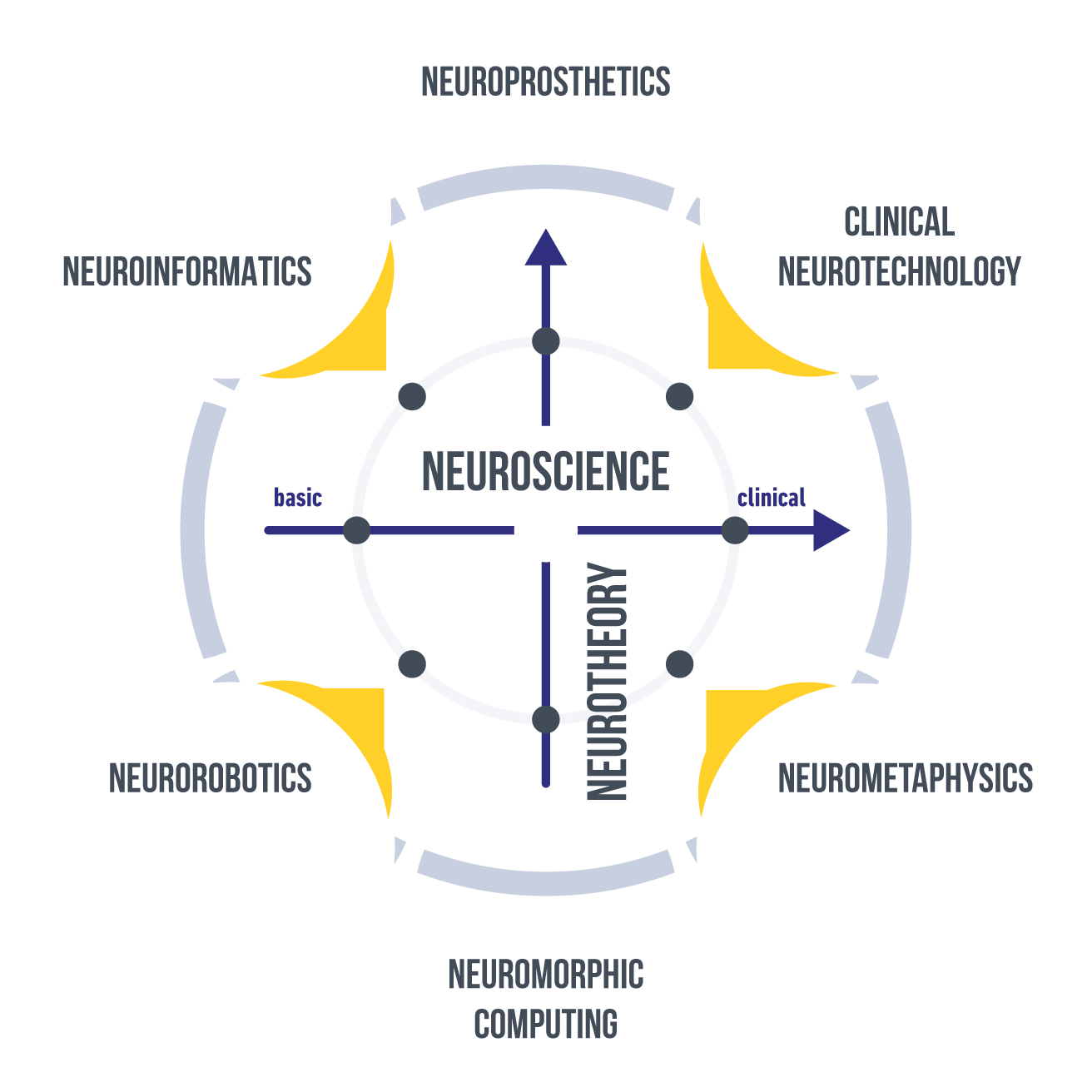
Our Mission
Neurotechnology (NT) focuses on the realization of a broad set of methods, concepts, artificial systems and technologies that aim to understand, interact with, repair, enhance, and directly influence the brain and behaviour. In other words: technology from the brain, for the brain and with the brain. NT provides strategic bridges between various disciplines, including neuroscience, medicine, engineering, artificial intelligence, cognitive science, and robotics. In addition, it links to philosophy, design, ethics and law. NT takes on a special status with respect to the explanation of the structure and function of the brain because it emphasizes the role of synthesis in understanding nature or following the 18th-century scholar Giambatista Vico: the truth and the made are reversible (“factum et Verum convertuntur”)[1]. In other words, the impact of neurotechnology is twofold. On the one hand, it transforms our understanding of the brain into technology relevant to a broad range of application areas, including neuroscience itself, on the other, it is a distinct methodology to advance our understanding of the fundamental principles underlying mind and brain[2].
[1] G Vico, Scienza Nuova Seconda, The New Science of Giambattista Vico, Revised Translation of the Third Edition by Thomas Goddard Bergin and Max Harold Fisch (Ithaca: Cornell University Press, 1948; Cornell Paperbacks, 1976., 1730).
[2] Paul F M J Verschure and Tony J Prescott, “A Living Machines Approach to the Sciences of Mind and Brain,” Living Machines: A Handbook of Research in Biomimetics and Biohybrid Systems, 2018, 15.
The specific expressions of NT can take many forms, including bioelectronics, brain-computer interfaces, neuromodulation methods using an electrical, chemical, optical or sound-based coupling, implantable devices, neuromorphic hardware and control, wearables, neurofeedback systems, neuroprosthetics, non-invasive modulation using AR/VR/XR methods and methods for cognitive augmentation[1]. To advance this panoply of possibilities we should define the map on which they are placed. NeurotechEU posits an eight-dimensional space that defines the envelope of current and future research, education, and application of neurotechnology: 1) empirical and clinical neuroscience; 2) theoretical neuroscience; 3) neuromorphic computing; 4) neuromorphic control /neurorobotics; 5) neuroinformatics; 6) neuroprosthetics; 7) clinical neurotechnology; 8) neurometaphysics (neurophilosophy, neurolaw, neuroethics, neuroaesthetics, neurodesign). These dimensions will be described below.
1) Empirical and clinical neuroscience: neurotechnology is predicted on progress in neuroscience, an exponentially growing field. Neuroscience comprises many methods and technologies driving progress in the field, leading to a doubling period of the data generated every 7 years[2]. This technology-oriented approach toward science has defined a distinct development of neuroscience where the correlations between specific manipulations and observed brain states are the reporting standard rather than the strong inference over hypotheses on principles of brain organization. Indeed, it has been shown that the same data analysis approach towards deciphering the operations performed by a Commodore 64 processor fails to decode its algorithm or functions [3]. This challenge to empirical neuroscience is further illustrated by the lack of progress in diagnosing and treating leading neurological diseases such as stroke, addiction, and dementia. A noticeable exception is the field of Parkinson’s disease (PD), where deep brain stimulation (DBS) has become a standard treatment method, especially for patients where pharmacological interventions have ceased to be effective, i.e. a prime example of neurotechnology as a game-changer in the clinic [4]. Neurotechnology is both based on empirical and clinical neuroscience while providing enablers for progress in both domains;
2) Theoretical neuroscience: the development and deployment of technology require specifications of sufficient detail. For neurotechnology, these are derived from our understanding of the principles of organization of mind and brain. For instance, DBS is only viable because there is a mechanistic understanding of the symptomatology of PD, which includes over-inhibition of the subthalamic nucleus (STN), leading to a disruption of the recurrent flow of activity in the cortico-basal ganglia circuit. Hence, providing an external pace making of activity of the STN can be predicted to be effective, which has now become a standard of treatment. Hence, the field of theoretical or computational neuroscience provides an interface between empirical neuroscience and technology by articulating principles of neural organization, which lend themselves to further empirical evaluation and technical elaboration [5]. In addition, the linking of neuroscience and artificial intelligence promises to give rise to new brain-based approaches toward specialized and general artificial intelligence beyond current capabilities[6] [7];
3) Neuromorphic computing: Since Grey Walters and the early cybernetics movement of the 1940ies, attempts have been made to emulate neuronal circuits and their operations in electronic hardware. This has given rise to the field of neuromorphic computing, which was initiated in the late 1980ies by Carver Mead and Misha Mahowald at Caltech. The need for these alternatives to the standard von Neumann computer architecture is that it promises to achieve high computational density while reducing the power needs[8]. This approach is also seen as an alternative paradigm for computational hardware now that the exponential scaling of transistor density expressed in Moore’s law is nearing an asymptote [9]. Neuromorphic hardware will also constitute an enabler for many applications of neurotechnology by providing brain-compatible computation at low power. This field also provides interfaces to material science and computer science;
4) Neuromorphic control /neurorobotics: The brain operates as an integrated architecture that is interfaced with the world through sensors and effectors. Indeed, the field of morphological computation posits that the biomechanics of biological bodies provide implicit computation which offloads the central controller, i.e. the brain. The field of Neurorobotics thus combines the power of neuromorphic computation with the constraints of real-world interaction, embodiment, and control. This is of specific relevance to the emerging field of soft robotics, which mimics the compliance and dynamic configuration of biological bodies, enhancing the functionality and safety of robots. This new generation of robots requires new forms of biologically grounded control, requiring advanced in neurorobotics;
5) Neuroinformatics[10]: The tools built for studying the brain will converge with those needed to analyze and control artefacts derived from our growing understanding of the brain. For this reason, developing such convergent tools and methods comprises a strategically critical dimension that will enhance the coherence of approaches between neuroscience and neurotechnology and strengthen the synergy between these fields. In addition, given the trend in Neurotechnology toward complete integrated systems as opposed to discrete components, the core challenge of the field is to articulate a multi-scale theory of the brain based on which design decisions can be made, as opposed to being driven by what is technologically opportune. This calls for advancing reference whole-brain models as a core activity in neuroinformatics[11].;
6) Neuroprosthetics: In a general sense, neuroprosthetics is a paradigmatic field of neurotechnology since it combines sensing of brain states, their transformation in a functionally appropriate way of this input, and lastly, the functional modulation of brain states as a result of this transformation[12] [13]. Hence, defining a feedback system with distinct stages: input sampling, signal processing, transformation, output preparation, and stimulation, not unlike how the 19th-century Dutch psychologist Franz Donders decomposed mental processes. Each of these stages represents a universe of scientific and engineering challenges, from the design of effective interfaces and the identification of proper representational coding formats (e.g. rate, time, frequency, phase, single-cell, population) to the task-specific transformation of input signals and the drive onto neural and or skeletal-muscle systems to effectuate task-specific change taking into consideration appropriate weight, power, communication, energetic, and biocompatibility constraints. Neuroprosthetics thus builds on advances in the other dimensions of neurotechnology, exercising and testing our understanding of the principles of brain organization in the service of society;
7) Clinical neurotechnology: Bringing interventions to patients and health users in the clinic or at home requires embedding specific intervention and monitoring systems in integrated human-in-the-loop digital brain health pipelines [14]. These pipelines must be built and tuned to the specific neurotechnologies they deploy for assessment, diagnostics, and intervention, including advancing patient-specific whole-brain models. The deployment of these systems will radically impact how health care is provided and thus comprises a distinct domain of study and education. The objective of digital brain health must be to realize systems that have relevance in the real world, both given current challenges and future ones. In this effort, the strategic choice would be to link medium- and long-term research and education objectives to fundamental challenges in digital brain health, including education and cognitive augmentation. Digital brain health should be structured along the known challenges society faces in neurological disease and beyond, i.e. in terms of concrete and accepted metrics for the burden of disease to assure impact;
8) Neurometaphysics (neurophilosophy, neurolaw, neuroethics, neuroaesthetics, neurodesign): At the heart of advanced research and education are concepts, methods, and skills. These are also predicated on considerations and analyses beyond biological systems’ physics and chemistry. For this reason, advances in neurotechnology must be intrinsically coupled to core domains of the humanities. For instance, neuroprosthetics requires detailed neuroethics analyses and guidance, advanced biologically grounded general intelligence requires legal assessment, while the study of consciousness, agency, and volition requires proper philosophical frameworks [15]. As the product of evolution, the brain is marvellously effective in surviving in complex, partially unknown environments. However, currently, humanity finds itself in the Anthropocene and limitations of human perception, cognition, action, and experience are becoming one of the main liabilities to finding sustainability of the planet’s physical, ecological, social and cultural systems. Neurotechnology is one of the strategic areas which can directly contribute to finding new solutions to augment human mental capability to respond more appropriately to current challenges, such as new sensing capabilities, memory enhancement, optimized decision-making, improved education, etc. Yet, each raises fundamental philosophical and legal challenges that need to be analyzed with care. Conversely, neurotechnology can challenge the humanities to rethink their approaches, for instance, design, as illustrated by the emerging field of neuroarchitecture. Lastly, neuroaesthetics is a new paradigm that has given rise to new art forms capitalizing on autonomy and interaction, providing opportunities for training and research beyond the proximal zone of the known [16].
[1] Gray Scott, “The Neurotechnology Revolution Has Arrived,” Futurist 47, no. 5 (2013): 6–7, https://doi.org/10.1038/464674a.
[2] Ian H Stevenson and Konrad P Kording, “How Advances in Neural Recording Affect Data Analysis.,” Nature Neuroscience 14, no. 2 (2011): 139–42, https://doi.org/10.1038/nn.2731.
[3] Eric Jonas and Konrad Paul Kording, “Could a Neuroscientist Understand a Microprocessor?,” PLoS Computational Biology 13, no. 1 (2017): e1005268.
[4] Andres M Lozano et al., “Deep Brain Stimulation for Parkinson’s Disease: Disrupting the Disruption,” The Lancet Neurology 1, no. 4 (2002): 225–31.
[5] P S Churchland and T J Sejnowski, The Computational Brain (MIT Press, 1992); Michael A Arbib and James J Bonaiuto, From Neuron to Cognition via Computational Neuroscience (MIT Press, 2016).
[6] Demis Hassabis et al., “Neuroscience-Inspired Artificial Intelligence,” Neuron 95, no. 2 (2017): 245–58.
[7] Diogo Santos-Pata et al., “Epistemic Autonomy and the Mammalian Hippocampus: Bootstrapping Gradient Descent Learning,” Trends in Cognitive Science, 2021.
[8] Catherine D Schuman et al., “A Survey of Neuromorphic Computing and Neural Networks in Hardware,” ArXiv Preprint ArXiv:1705.06963, 2017.
[9] Charles E Leiserson et al., “There’s Plenty of Room at the Top: What Will Drive Computer Performance after Moore’s Law?,” Science368, no. 6495 (2020).
[10] Shun-Ichi Amari et al., “Neuroinformatics: The Integration of Shared Databases and Tools towards Integrative Neuroscience,” Journal of Integrative Neuroscience 1, no. 2 (December 2002): 117–28, http://www.ncbi.nlm.nih.gov/pubmed/15011281.
[11] Petra Ritter et al., “The Virtual Brain Integrates Computational Modeling and Multimodal Neuroimaging,” Brain Connectivity 3, no. 2 (2013): 121–45.
[12] James Wright et al., “A Review of Control Strategies in Closed-Loop Neuroprosthetic Systems,” Frontiers in Neuroscience 10 (2016): 312.
[13] Dawn M Taylor, Stephen I Helms Tillery, and Andrew B Schwartz, “Direct Cortical Control of 3D Neuroprosthetic Devices,” Science296, no. 5574 (2002): 1829–32.
[14] Nina Schwalbe and Brian Wahl, “Artificial Intelligence and the Future of Global Health,” The Lancet 395, no. 10236 (2020): 1579–86.
[15] Hannah Maslen, Jonathan Pugh, and Julian Savulescu, “The Ethics of Deep Brain Stimulation for the Treatment of Anorexia Nervosa,” Neuroethics 8, no. 3 (2015): 215–30.
[16] D D Cinzia and G Vittorio, “Neuroaesthetics: A Review,” Current Opinion in Neurobiology 19, no. 19828312 (2009): 682–87, https://doi.org/papers://FAFC0638-5DD4-4A81-A69F-F8A54DFE70C3/Paper/p39180.

Campus+
- Learn about courses on offer
- Meet with their peers
- Follow online courses
- Manage their blended learning experience
Graduate School
- Each student will be advised by 3 mentors; two from partnering universities and the third from the industrial or societal partners
- All projects will focus on a Neurochallenge, i.e. societal challenge that can be met by neuroscientific knowledge and/or neurotechnological solution
- Admissions to this top-tier graduate school will be highly competitive and centrally organized
- By graduation each student will have an intersectoral experience with a strong multidisciplinary research background


Lifelong Learning Center
- Deliver the necessary knowledge, skill sets and competencies for continued learning throughout life
- Help individuals to adapt to the changing personal, civic, societal and employment related needs
- Provide access to the necessary education and experience for individuals to pursue opportunities in brain research and technologies
- Organize certificate programs, micro-degrees, boot-camps, and offer internships, research opportunities and transferable skill training
NeurotechEU Spaces
- Provide tools to create, store and share information safely on the cloud
- Offer streaming and messaging platforms for real-time communication
- Issue shared blackboards, sandboxes and digital lockers
- Help create a paperless European University


NeurotechEU Ecosystem
- Students to have easy access to internships, apprenticeships and intersectoral training opportunities
- Companies to access skilled and creative individuals
- To create new business opportunities through knowledge and technology transfer from universities to (societal) stakeholders
- Assist NeurotechEU with the development of new technologies to diversify and improve education
